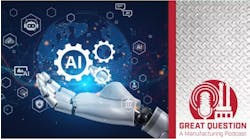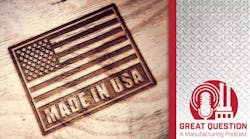Bright Machines' Adam Montoya
With labor shortages, mismatched skillsets, and production bottlenecks, there’s no denying that manufacturing is at an inflection point. The challenges are mounting within factories that have outdated solutions and can’t pivot fast enough to meet changing consumer demands.
But manufacturers can control how quickly they embrace factory digitization and intelligent automation. Simply put, those who welcome modern means of production will have a decided leg up on their competition, and those who don’t won’t.
Challenges are outpacing change
Manufacturers who are slow to adopt today’s technology boom will continue to feel effects of some of the industry’s most common challenges—both those that have existed for generations and those compounded by the pandemic.
Challenges include modern customers’ increasing demands, which not only puts pressure on manufacturers to be able to quickly pivot to deliver unprecedented service, it also puts an even greater strain on an already-delicate supply chain. The pandemic-prompted materials shortage and supply chain disruption hit hard in 2021 and was made worse by the labor shortage that saw a record 4.5 million Americans quitting their jobs in November.
Unfortunately, the industrial sector was already experiencing a labor crisis. Even with more workers available, US manufacturers believe that finding the right talent is now 36% harder than it was in 2018, according to a Deloitte and Manufacturing Institute report.
Other challenges have been lurking for decades. Facilities running with legacy equipment and outdated hardware will undoubtedly experience challenges in keeping keep up with their competitors who have already implemented data-driven automated solutions. Traditional manufacturing solutions that attempt to link together disparate systems—most of which speak different languages—can run into real operational obstacles, mainly not fully capitalizing on their data.
Many companies have insightful data on hand, but vary in how they are able to leverage that information. For example, are they using it to understand and improve the quality rate of the end-product? To predict supply chain disruption? To get closer to customers' point-of-consumption? To shorten their product lifecycle, so they can more efficiently produce newer versions of the product and achieve faster time to market?
The insights may be within reach, but not all manufacturers have the right solutions to enable them to take full advantage of everything that data can provide.
Innovation and impact is within reach
Manufacturers who embrace next-generation manufacturing solutions will find themselves in the desirable position of being able to innovate quickly to meet their end customers’ demands. A full-stack approach—one that leverages intelligent software and adaptive robotics—has benefits that can be felt immediately and in the long run:
1. Optimized operations—Digitizing a factory immediately provides manufacturers what they once took months to build, from real-time notifications to a deeper understanding of performance to diagnostic dashboards. These capabilities will have a massive impact on overall efficiency, provide greater visibility into production, and allow for faster response time to issues. Real-time notifications and diagnostic dashboards, for instance, give maintenance engineers the ability to identify the root cause of an equipment issue and respond to it by leveraging diagnostic tools within the solution, instead of waiting for equipment failure.
2. Speed and scale—Manufacturing lines no longer have a single life; switching between products and extending learnings from well-running lines to other factories should be expected from the next generation of automation. Think of the factories responsible for cellphone components that need to redefine their lines to prepare for the newest model. Intelligent automation provides access to capabilities and dashboards to deeply understand how the line is running and repurpose the existing machines quickly for the new product. When demand expands, a manufacturer can even replicate production at new or existing locations.
3. Increased resiliency—Many manufacturers still rely on gathering data from sensors and cameras and then conducting a manual analysis to determine where issues occur and where there may be opportunities to improve efficiency. This process is slow and tedious, and teams can be left scrambling in the face of threats to production.
With intelligent automation, greater flexibility and adaptability are derived from the ability to make adjustments to the types of data and dashboards that teams monitor, helping strengthen the decision-making process by understanding where challenges are across the production line. This is incredibly important as manufacturers everywhere are tasked with ensuring operational resiliency so they can be prepared to tackle disruption when the unplanned and unpredictable happens.
Ultimately, modern solutions make room—meaning more time and resources—for manufacturers to innovate and strive for constant improvements rather than simply keeping things running. This can lead to the introduction of transformative technologies such as artificial intelligence and industrial robotics. It could look like having new tools and insights available to ensure safer, more efficient practices throughout facilities. Or it could mean implementing sustainable, eco-friendly methods that could be adopted as the industry standard.
Innovation inevitably leads to positive change, and the manufacturing industry needs new solutions that look and feel better for the entire chain.
It’s time to rethink manufacturing’s potential. As consumer preferences continue to change and manufacturers feel pressure mounting in their global supply chain, factory digitization and intelligent automation provide the ability to embrace a new, more competitive world. The value is not only in pivoting quickly to meet demand; the operational improvements made possible by a full-stack approach to automation also give the workforce better, more fulfilling opportunities, and companies will emerge more competitive and more resilient than ever.
Adam Montoya is vice president of industrial automation with Bright Machines


